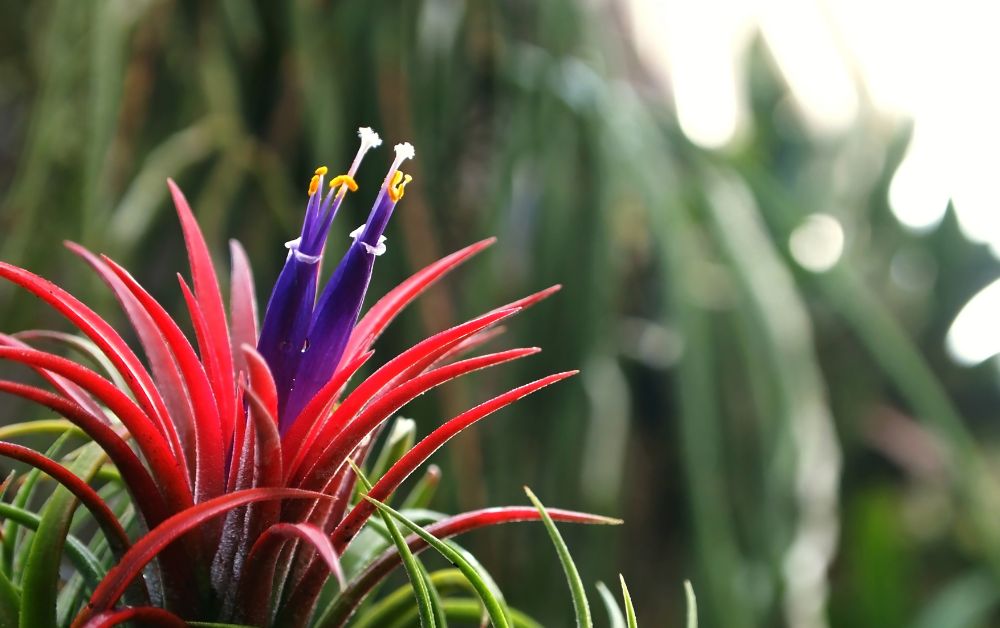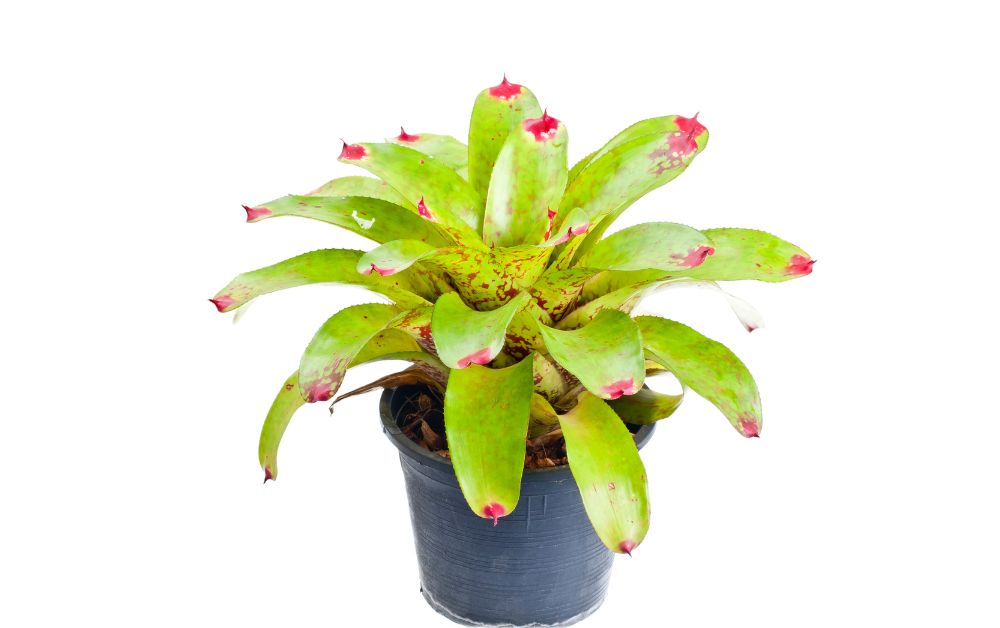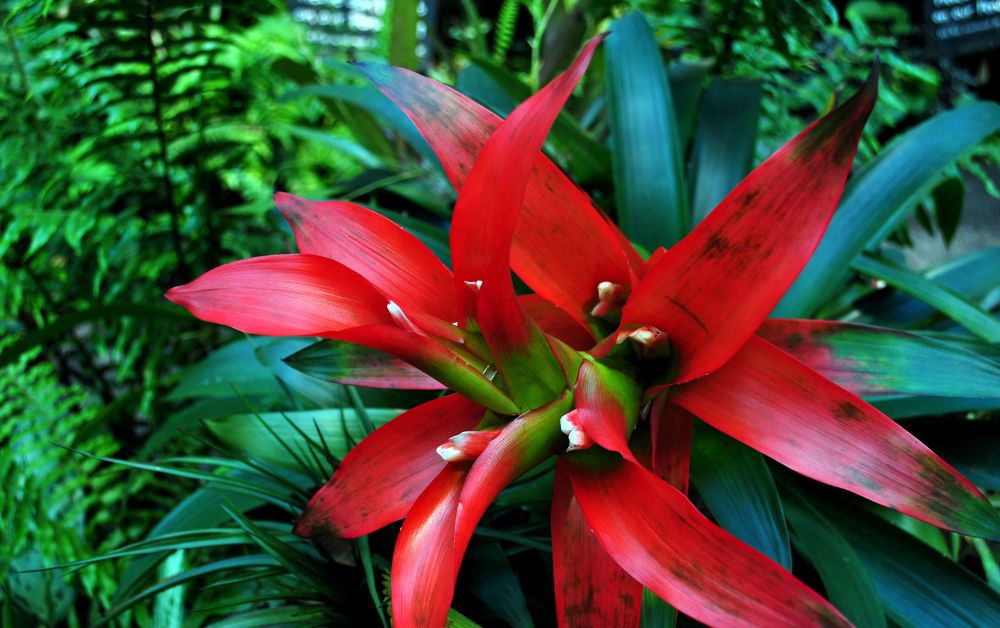Last Updated on May 10, 2025 by teamobn
Bromeliads are exotic, colorful tropical plants prized for their long-lasting blooms and striking foliage. Many gardeners assume they’re finicky, but with basic bromeliad care guidelines you’ll be surprised how easy these plants can be. This bromeliad care guide covers the essentials—like light, water, soil, humidity, fertilizing, and pest control—to keep your plants lush and vibrant. Whether you’re just starting or have some plant experience, you’ll find practical tips to nurture happy bromeliads in your home or garden.
Bromeliad Care Complete Guide
Contents
Bromeliads may look exotic, but their care routine is surprisingly manageable. This gardening guide will walk you through the essentials of bromeliad care, from light and water to feeding and propagation.
Light
Bromeliads thrive in bright but indirect sunlight, mimicking the dappled light of a tropical understory. They generally need indirect sunlight to grow well and produce flowers. Place them near an east- or west-facing window, or provide filtered light through sheer curtains.
Direct, harsh sun can scorch leaves, so it’s best to avoid noon sun on sensitive plants. Keep in mind bromeliads also like warmth: daytime temperatures between 60°F and 85°F (16–29°C) are ideal. In shaded conditions, foliage may turn dark green, and blooms may be sparse, so find a balance for bright, even lighting.

Water
Proper watering is key to healthy bromeliad care. Most bromeliads have a natural “tank” – a rosette of leaves that holds water. Water the central cup (tank) of the plant rather than drenching the soil. The tank should be kept filled with water at all times. However, be careful not to let that tank overflow into the potting mix.
Excess water in the soil can cause root rot, since bromeliads are prone to rot if the soil stays wet. Empty and refill the tank periodically (about once a month) to avoid stagnation and salt buildup. In winter or cooler months, water less frequently. A good routine is to top up the tank once every 1–2 weeks in warm weather and let it dry slightly between waterings. Use room-temperature water, preferably rainwater or filtered water if your tap is high in minerals. If you have a terrestrial bromeliad (one that grows in soil rather than on trees), water the soil lightly and rely mainly on the cup for moisture.
Soil
Choose a well-draining, airy growing medium to prevent sogginess. Many bromeliads are naturally epiphytic (tree-growing), so they prefer light, porous soil rather than heavy potting mix. A typical mix might include orchid bark, peat moss or coco coir, and perlite. The key is good drainage. You can use a commercial bromeliad or orchid mix, or make your own blend (for example, 1 part peat, 1 part pine bark, 1 part perlite).
Plant the bromeliad at the same depth as it was in its nursery pot, with the base of the leaves just above the soil surface. For aerial or mounted bromeliads (like many Tillandsia), you can attach them to bark, wood or Spanish moss; they will live off the moisture in the air. In all cases, ensure your pot or mounting allows excess water to drain out; standing water around the roots invites rot.
Humidity
Bromeliads love humidity. In their tropical native habitats, humidity often exceeds 50%. Most homes are drier, so you may need to boost moisture around your plants. Bromeliads need humid air to prosper. Misting the leaves regularly or using a humidity tray can help. Grouping plants together can raise local humidity, as plants transpire moisture.
You might also place bromeliads in kitchens or bathrooms (with adequate light), since these rooms tend to be more humid. For sensitive species like air plants (Tillandsias), keep humidity even higher; they should be misted more frequently (every 2–3 days) to meet their moisture needs.
If you have trouble maintaining humidity, a small indoor humidifier works wonders. Just be sure there is good air circulation to prevent fungal issues: a gentle fan or an open window (without drafts) can help balance moisture and airflow.
Feeding
Bromeliads are light feeders compared to many garden plants. Feed them sparingly to avoid burning the leaves. A diluted, balanced liquid fertilizer is best. For example, use a half-strength houseplant fertilizer once a month during the growing season. You can apply the fertilizer directly into the tank or spray it onto the leaves.
Foliar feeding (spraying leaves) is effective because bromeliads absorb nutrients through their leaf scales. Avoid heavy or frequent fertilizing, which can accumulate salts. Some growers only feed when they see new growth. Another tip: flush the central cup occasionally with plain water (as mentioned) to rinse out old fertilizer. In general, a light feeding schedule keeps bromeliads healthy without the risk of fertilizer burn.
Pests and Diseases
Generally, bromeliads are pretty pest-free, but they can occasionally attract a few common houseplant pests. Most problems arise from poor airflow, excessive dryness, or overwatering. Here’s a list of pests and diseases to watch for:
- Scale Insects: Appear as small brown or black bumps on leaves. They suck plant sap and can weaken the plant over time.
- Mealybugs: Look like small, white cottony patches, especially near leaf joints. They feed on sap and can spread quickly.
- Spider Mites: Thrive in dry indoor conditions and leave fine webbing on leaves. Regular misting and higher humidity help deter them.
- Root Rot: Caused by consistently wet soil. Signs include a mushy base or a foul smell from the roots.
- Crown Rot: Starts in the center of the plant and often results from stagnant water in the tank or poor drainage.
To manage these issues, remove pests with insecticidal soap, neem oil, or rubbing alcohol. For rot, trim away affected parts and repot using sterile tools and fresh mix. Consistent airflow, good drainage, and avoiding overwatering will help prevent most problems. Keep your bromeliads clean and check them regularly to ensure they stay healthy.

Propagation
Bromeliads typically reproduce by producing offsets, often called “pups,” after the main plant flowers. Propagating by pups is the most common method for hobbyists. Once a bromeliad flowers, the central rosette will slowly decline; but before it dies, it will produce several small pups around its base. These pups can be removed and grown on. Wait until a pup is at least one-third to half the size of the parent plant (usually when it has 3–4 leaves). Then use a clean, sharp knife to cut the pup away, making sure to include its roots. Pot the pup in its own bromeliad mix.
You can plant several pups together in one pot for a dramatic clump or separate them individually. Alternatively, some bromeliads can be propagated from seed, though this is slow and typically used by specialists. For home gardeners, dividing pups is far easier. If you want to force flowering (and thus get pups sooner), there’s a trick: enclosing the plant with a ripe apple can hasten bloom. After flowering, the parent will eventually die back, but by then you will have new plants (pups) to carry on your bromeliad collection.
Companion plants to include with bromeliads
Bromeliads naturally fit into tropical-style plantings and pair well with other plants that enjoy humidity and indirect light. Choosing the right companions helps create a balanced microclimate and enhances the visual appeal of your garden. Here are some excellent choices:
- Ferns (e.g., Boston fern, maidenhair fern): Both enjoy similar humidity and light levels, creating a lush, layered look.
- Anthuriums: Their bold, colorful spathes and glossy leaves complement bromeliads’ vibrant structure.
- Peace Lilies: Match bromeliads in water and light needs and provide soft contrast with white blooms.
- Philodendrons: Their climbing or trailing growth adds height and movement around bromeliads.
- Pothos: Easy to grow, they bring texture and help fill gaps in bromeliad groupings.
- Calatheas: Known for striking leaf patterns, they add bold foliage to a shared tropical display.
- Alocasias: Their large, dramatic leaves contrast well with the compact form of bromeliads.
- Tillandsias (Air Plants): Share similar needs and can be mounted or arranged creatively alongside bromeliads.
- Orchids: Thrive in the same environment and add delicate, long-lasting flowers to the mix.
Avoid pairing bromeliads with plants that prefer dry conditions or heavy feeding, such as cacti or succulents. These combinations will create mismatched environments that stress one or both types. By grouping tropical species together, you build a thriving, exotic garden corner that benefits from shared humidity and light preferences.

The benefits of growing bromeliads
The benefits of growing bromeliads go far beyond their striking appearance. With simple bromeliad care, these plants reward gardeners with long-lasting color, minimal maintenance, and adaptability to indoor or outdoor settings. Their ability to thrive with basic attention makes them a standout choice for both beginners and seasoned plant lovers.
- Vibrant Color and Unique Foliage: Bromeliads are showstoppers. They come in a rainbow of colors – from neon reds and oranges to soft pinks and greens – and their foliage often has striking patterns. Even when not in bloom, many (like Neoregelia species) display beautiful banded or scalloped leaves. Their long-lasting flower spikes or colorful bracts provide a tropical accent that few other houseplants can match.
- Easy, Low-Maintenance Plants: As noted in our low-maintenance plant guide, some plants thrive even with the lack of care. Bromeliads fit that description. They tolerate occasional neglect thanks to their tank habit and drought-tolerant leaf scales.
- Long Bloom Period: When a bromeliad does flower, it usually holds color for weeks or even months. That means you get a bright, cheerful focal point for a long time.
- Air Purification and Well-being: Bromeliads can improve air quality by absorbing pollutants like many indoor plants. Their lush presence also adds a sense of calm and exotic beauty.
- Wildlife Attraction (Outdoor Gardens): In tropical or subtropical gardens, bromeliads can collect rainwater in their tanks, offering mini-ecosystems for frogs, insects, or lizards.
- Versatility: Bromeliads can be grown indoors, in terrariums, or outdoors (in frost-free areas). Their adaptability makes them a creative choice for gardeners looking to add tropical flair.
Conclusion
Whether you’re sprucing up an indoor plant collection or designing a lush garden bed, mastering bromeliad care will reward you with long-lasting color and interest. These plants prove that a little tropical flair is possible for any gardener, even busy ones, as long as you cover the basics of light, water, and humidity. By following the tips above (and checking out our posts on tropical garden design and low-maintenance plants for inspiration), you can ensure healthy, vibrant bromeliads. With proper bromeliad care, your plants will thrive and fill your space with exotic beauty for years to come.
We have more amazing flower guides. Check out our colored flower article!








